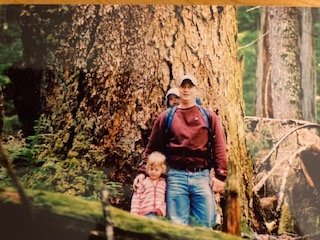Simard discovered, to her surprise, that the forest has trees that are "ancient giants. . . . social beings that exchange nutrients, help one another, and communicate to others."* She named them "the Mother Trees" and made a commitment to take their discovery to global awareness.
"Go find a tree—your tree," Simard encourages her readers. "Imagine linking into her network, connecting to other trees nearby. Open your senses."* My chosen tree is nearby. She is old with a big girth. I've set a chair near her for visiting. To date, I've stopped several times, only leaning my back against her, for now, and just for moments . . . then having closed my eyes, inwardly I speak to her.
My realization is, "A shift in how we see trees, from being useful for shade, protection, producing crops, providing building material, or offering beauty may expand to a personal relationship that we could name 'in friendship,' or even 'as mothering.'"
* Prema Jasmine Camp, A Flower for God: A Memoir (Seattle, WA: Wilson Duke Press, 2021), 40.
* Camp, 44.
* Suzanne Simard, Finding the Mother Tree: Discovering the Wisdom of the Forrest (New York: Alfred A. Knopf, 2021), 50.
* Simard, 50.
* Richard Schiffman, "'Mother Trees’ Are Intelligent: They Learn and Remember,” Scientific American, May 4, 2021, para 2, https:// www.scientificamerican.com/article/mother-trees-are-intelligent-they learn-and-remember.
* Simard, 305.




